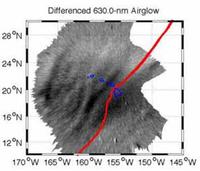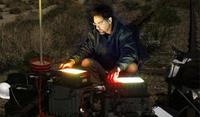-
Purdue helps Chicago prepare for disasters
To be better prepared for a major natural disaster or a terrorist attack, seventeen counties near Chicago, Illinois have banded together to create a disaster preparedness plan with the help of Purdue University and the University of Illinois, Chicago
-
-
Napolitano addresses Public Private Partnership conference
DHS secretary Janet Napolitano spoke to the attendees and reiterated the private sector’s role as an important partner in strengthening the homeland security enterprise better to defend against evolving threats, including disasters
-
-
Studying disasters in order to prepare for them
Disaster Research Center scientists study the world’s worst disasters in hopes of saving more lives in the future; one of the center’s experts says that disaster planning is constantly changing: “As we have a combination of new threats that face us — natural and technological — as we have changes in climate, as we have changes in population density, in where people are living, people are put at risk and new issues are created”
-
-
Method for early detection of tsunami found

Researchers, for the first time, have recorded an airglow signature in the upper atmosphere produced by a tsunami; the signature, caused by the 11 March earthquake that devastated Japan, was observed in an airglow layer 250 kilometers above the Earth’s surface; it preceded the tsunami by one hour, suggesting that the technology could be used as an early-warning system in the future
-
-
Louisiana parish plans extreme weather alert system
Emergency officials in Ouachita Parish, Louisiana are considering installing warning sirens that would alert residents of dangerous weather; officials hope to install sixty towers throughout the Parish; authorities are currently conducting feasibility studies to determine if installing the sirens is practical and a financial possibility
-
-
Era of major volcanic eruptions nears

The recent volcanic eruptions in Iceland upset airline bosses and caused a lot of fuss, but they were trivial by comparison with what could happen next, according to Clive Oppenheimer’s new book; 10 percent of the world’s population and at least twelve major cities now located within range of a volcano, so a more accurate perspective is needed on what they can do, so that rational plans can be drawn up in preparation for future events
-
-
St. Louis hit by earthquake, heat wave, and cicadas
For residents of Missouri still struggling to resume their daily lives after a deadly tornado killed 141 people and destroyed hundreds of thousands of dollars in property, the Federal Emergency Management Agency (FEMA) has reopened its Disaster Recovery Center in St. Louis county; working in conjunction with the Small Business Administration (SBA), FEMA will provide assist business owners and residents affected by the tornadoes by providing low interest loans for repairs to damaged or destroyed property; beleaguered residents suffered another blow on Tuesday as a small earthquake struck just outside of St. Louis; the earthquake was relatively minor and resulted in no deaths or injuries; the quake had a magnitude of 4.2 and its epicenter was located fifty miles southwest of St. Louis; the city is struggling to stay cool amidst record heat as they rebuild; on Monday temperatures soared to a record ninety-seven degrees
-
-
Envisage Technologies to provide Indiana DHS with software
On Wednesday Envisage Technologies announced that it was working with the Indiana Department of Homeland Security (IDHS) to implement the third phase of its state-wide readiness strategy; Envisage will expand its Acadis Readiness Suite, an integrated software tool that automates complex logistical tasks that normally require a host of various databases, software, and systems, to include secure certification of users; state officials say that the added software capabilities will help agencies more accurately assess resource needs and respond more quickly in emergencies
-
-
Scientists detonate underground bombs in California for earthquake research

To study California’s fault lines, researchers recently detonated explosives underground to create 3D models of seismic activity; a team of geologists and seismic experts travelled to areas in the Imperial and Coachella Valley, roughly 150 miles northeast of San Diego, California, to study the southern tip of the San Andreas Fault; a team detonated more than 120 explosives more than sixty feet deep to set off seismic waves; the team measured these wave patterns with 3,000 different sensors to create a 3D map in these fault areas; their work comes as part of the Salton Seismic Imaging Project
-
-
CDC instructs on preparations for Zombie Apocalypse
There are many exotic diseases the Atlanta-based U.S. Centers for Disease Control and Prevention (CDC) is investigating, and about it which it warns Americans; few followers of the health agency were prepared for its latest post: “Preparedness 101: Zombie Apocalypse”; the post, written by Assistant Surgeon General Ali Khan, instructs readers how to prepare for “flesh-eating zombies” – zombies similar to those one sees in movies like “Night of the Living Dead” and video games like Resident Evil; CDC spokesperson said: “It’s kind of a tongue-in-cheek campaign—- We were talking about hurricane preparedness and someone bemoaned that we kept putting out the same messages”
-
-
New slippery slopes detection system developed
One result of climate changes has been that the number of avalanche threats has been increasing in the Alps and other alpine regions, with fatal consequences for people and infrastructures; continuous monitoring of every endangered area has been lacking until now because of high costs and manpower requirements; German scientists have now developed an inexpensive system, which, with the help of several technologies, can continuously monitor slopes, assess changes, and provide early warnings to communities potentially affected by landslides
-
-
Lompoc, CA prepares for the big quake
Following the 11 March earthquake and tsunami that struck Japan, Lompoc, California is evaluating its own earthquake preparation should a similar 9.0 magnitude strike; while Lompoc may be safe from a tsunami, the town is woefully unprepared for a major earthquake; Bruce Taylor, Lompoc’s former building safety inspector, bluntly stated that many buildings would not stand up to a major earthquake; to ensure that its buildings are seismically safe, the city of Lompoc is offering incentives and funding to help property owners evaluate their buildings and conduct seismic retrofits
-
-
California school building regulators had ties with anti-regulation lobby group
A California watchdog group recently revealed that state officials in charge of enforcing earthquake standards for school buildings have had a long and questionable relationship with a lobbying group that actively works to oppose building safety regulations in public schools; senior officials with the Division of the State Architect had been dues paying members of the Coalition for Adequate School Housing, which actively lobbies for less regulation on school construction; in 1997, state regulators were told that taxpayers would reimburse their membership dues to be a part of the lobbying group; officials maintain that there has been no corruption; in 2010 a major regulatory provision in place since 1933 was removed
-
-
AT&T shows mobile cell towers for disaster communication

A new family of solutions from AT&T will make business, government, and public safety agencies better prepared for natural or man-made disasters; one of the new offerings, the “Fly-away” solution, packs a small cell site into a suitcase, offering first responders an easy-to-use, transportable system that can bring voice and data coverage to an area where disaster has knocked out communication channels
-
-
Wyoming braces for spring floods
The Wyoming Office of Homeland Security is readying local and state agencies for projected spring floods and is urging local residents to prepare themselves as well; this year large snow packs from heavy winter storms have increased the likelihood of flooding; state officials are encouraging families to keep a three-day emergency kit loaded with food, water, clothing, flashlights, medicine, and important documents; last year floods hit Wyoming causing major disruptions, particularly in Fremont County; this year state officials hope to minimize the impact of floods with early preparation
-
- All
- Regional
- Water
- Biometrics
- Borders/Immig
- Business
- Cybersecurity
- Detection
- Disasters
- Government
- Infrastructure
- International
- Public health
- Public Safety
- Communication interoperabillity
- Emergency services
- Emergency medical services
- Fire
- First response
- IEDs
- Law Enforcement
- Law Enforcement Technology
- Military technology
- Nonlethal weapons
- Nuclear weapons
- Personal protection equipment
- Police
- Notification /alert systems
- Situational awareness
- Weapons systems
- Sci-Tech
- Sector Reports
- Surveillance
- Transportation
Advertising & Marketing: advertise@newswirepubs.com
Editorial: editor@newswirepubs.com
General: info@newswirepubs.com
2010-2011 © News Wire Publications, LLC News Wire Publications, LLC
220 Old Country Road | Suite 200 | Mineola | New York | 11501
Permissions and Policies
Editorial: editor@newswirepubs.com
General: info@newswirepubs.com
2010-2011 © News Wire Publications, LLC News Wire Publications, LLC
220 Old Country Road | Suite 200 | Mineola | New York | 11501
Permissions and Policies
